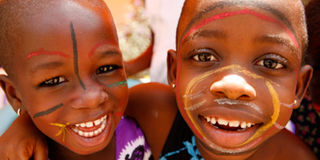Children with tuberculosis get sweet drugs

The new drug, which is quickly dispersible in liquid and easy for parents to give will give children hope. File photo
What you need to know:
Each year, about 1 million children get sick with TB. About 140,000 of those die, representing about 400 children each day mostly due to lack of drugs. However, as Lilian Namagembe writes, this is bound to change with the introduction of a new sweet drug.
Children suffering from tuberculosis will stop taking, bitter-tasting pills which require caregivers to cut or crush into multiple pieces to give the correct dose every day for six months.
Ministry of health permanent secretary, Dr Asuman Lukwago said Uganda will follow suit after the launch of the improved fruit-flavoured formulation drugs by neighbouring Kenya last week.
“We are aware of the developments and Kenya being a member of the East African Community where the partners have decided to first try the drug, it means Uganda can readily access it because we are now in a community,” Dr Lukwago said.
Uganda is among the 22 TB high burden countries of the world and the Ministry of Health’s National Tuberculosis and Leprosy Programme (NTLP) statistics indicate that children less than 15 years account for seven per cent of all TB cases reported each year.
Dr Lukwago explained that the child friendly medicine which dissolve in water and make them easier for children to take “is the same anti-tuberculosis drug but flavoured and so you can easily use it.”
The child-friendly forms of TB fixed dose combinations (FDCs) were introduced by the World Health Organsation (WHO) and partners in line with WHO dosing recommendations to improve treatment and child survival from TB, as well as slow the spread of drug-resistant TB.
The medicine which is a fixed combined dose of three drugs used to treat drug-sensitive TB (rifampicin, isoniazid, and pyrazinamide) is the first to meet dosage guidelines the WHO set in 2010.
The WHO estimates that 1 million children fell ill with TB in 2014, and 140,000 died from the disease. However, only around a third of those who catch the disease are officially diagnosed and put on treatment, the organisation warns.
Dr Simon Walusimbi the Makerere University Joint AIDS Programme (MJAP) tuberculosis adviser said several trials are on-going reassuring that “the same drugs will be launched here in Uganda anytime from now.”
The recent joint National coordination tuberculosis survey carried out by the Ministry of Health, Global Fund and the World Health Organisation indicated that the country’s annual number of new infections is at 100,000 cases compared to the previous estimated 60,000 cases.
Simple Treatments, Designed for Children
Improved medicines for children with drug-sensitive TB means tablets in the correct fixed dose combinations of the three most commonly used anti-TB drugs, rifampicin + isoniazid + pyrazinamide, used for the initial two months of treatment, followed by four months of rifampicin + Isoniazid. These products offer significant advantages over previous drugs including:
1. The Right Medicines
The right medicines in the right doses will improve adherence and save more lives. This is an important step in improving treatment and child survival from TB, and slowing the spread of drug-resistant TB.
2. Simple Medicines
Simple TB medicines for children eases the TB burden on healthcare systems. Simpler TB medicines for children can allow healthcare systems to scale up treatment. Fewer pills will simplify ordering and storage.
3. Child-Friendly Medicines
Child-friendly medicines improve the daily lives of children and their families struggling with TB. Six months is a long time to take medicine. But the availability of treatment that tastes good and is simple to provide will ease the daily struggles of children, parents, and caregivers alike.




